Narendra Modi
Personal Life
Narendra Modi was born in Vadnagar in Mehsana district which initially belonged to the state of Bombay but now in Gujarat. He was born on 17 September 1950 to Damodardas Mulch and Modi and his wife, Heeraben. Narendra Modi belonged to the backward community known as Ghanchi-Teli. Modi was the third child to his parents and did his schooling in Vadnagar which he completed in the year of 1967.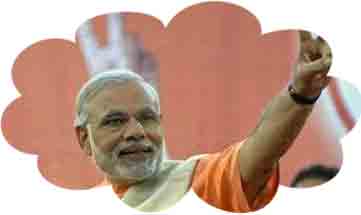 At school Modi was a very average student but was very much interested in theatre arts and was also a good debater. Apart from his school going time he helped his father by selling tea in a tea stall run by his father at Vadnagar railway station. Also when Modi was in his teenage he along with his brother ran a tea stall at a bus terminus. According to Ghanchi caste which Modi belonged to his parents got him engaged at the age of 13 to Jashodaben Chimanlal and when he turned 18 the marriage was performed.
At school Modi was a very average student but was very much interested in theatre arts and was also a good debater. Apart from his school going time he helped his father by selling tea in a tea stall run by his father at Vadnagar railway station. Also when Modi was in his teenage he along with his brother ran a tea stall at a bus terminus. According to Ghanchi caste which Modi belonged to his parents got him engaged at the age of 13 to Jashodaben Chimanlal and when he turned 18 the marriage was performed.But however the married couples lived together for a very short duration of time and they became hostile with each other as Modi wanted to follow his career by pursuing an itinerant lifestyle. So the marriage of Modi was broken. This broken marriage of Modi was never revealed to the public but was only acknowledged when his nomination was filed at the time of the parliamentary election in 2014.
At the age of 17 Modi left home and went to Ramakrishna Mission ashram in Rajkot and then to the Belur Math near Kolkata. However Modi did not continue in Almora for after that he travelled to Guwahati and then made himself as a part of another ashram set up by Swami Vivekananda in Almora, in the Himalayan foothills where he spent nearly two years of his time.
Then Modi took off to his home town and stayed there for a brief period of time and went back to Ahmadabad, where he lived and worked in a tea stall run by his uncle. During his time in Ahmadabad Modi got himself associated with Lakshmanrao Inamdar who was then based at Hedgewar Bhavan, the RSS headquarters in the city. Modi became a full time of the RSS in 1970 while he was working in the staff canteen of Gujarat State Road Transport Corporation.
However in the year 1978 Modi completed his under graduation from Delhi University in Political Science through Distance Education. Modi also secured his Master's degree in political science from Gujarat University in 1983. Narendra Modi still has an affinity for the principles of the Ramakrishna Mission also keeps visiting the Belur Math at regular intervals.
The political Guru and the mentor of Narendra Modi is Lakshmanrao Inamdar from RSS who is more commonly known as Vakil Saheb. This is how Modi slowly got into politics and soon Inamdar admitted as a balswayamsevak, a junior cadet in RSS. During his morning exercise session at the Keri pitha shakha of RSS, he also came in contact with Vasant Gajendragadkar and Nathalal Jaghda, leaders of the Jan Sangh who later founded the BJP's Gujarat state unit in 1980.
Early days in Politics
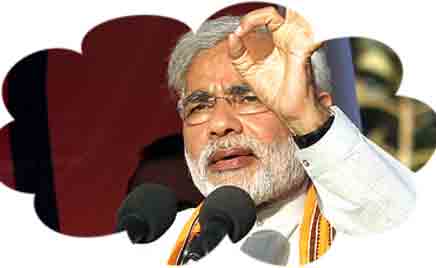 Even as Narendra Modi was very young he came into politics as a member of Rashtriya Swayamsewak Sangh (RSS). At the time of India Pakistan war in 1960, though Narendra Modi was very young he still came forward to perform duties to the soldiers traveling through railway stations for he was running a tea stall in the railway station at that time. Modi also became a member of a student body more popularly known as Akhil Bharatiya Vidyarthi Parishad which was fighting for a corruption free country.
Even as Narendra Modi was very young he came into politics as a member of Rashtriya Swayamsewak Sangh (RSS). At the time of India Pakistan war in 1960, though Narendra Modi was very young he still came forward to perform duties to the soldiers traveling through railway stations for he was running a tea stall in the railway station at that time. Modi also became a member of a student body more popularly known as Akhil Bharatiya Vidyarthi Parishad which was fighting for a corruption free country.When there was an emergency declared in the country by the then Prime Minister Indira Gandhi during 1975-1977 many political rivals were put behind bars and also number of political organization like RSS was banned. Modi went underground in Gujarat and to evade arrest was occasionally disguised as a Sikh, saint, elderly man etc. and printed and sent booklets against the central government to Delhi.
He also organized agitations and covert distribution of the Sangh's pamphlets under the leadership of Jayaprakash Narayan. The other primary role of Modi in this was to co-ordinate between activists in the state. Apart from this during this period Modi also wrote and published a book in Gujarathi which gives a written account of events, anecdotes as well as his personal experiences.
After looking at Modis service to the organization, RSS appointed Modi as its representative in the Bharatiya Janata Party in 1985. At the time of Modi's entry into BJP, Shankersinh Vaghela and Keshubhai Patel were very popular representing Gujarat. But soon Modi became very popular among the public especially after his organization of Murli Manohar Joshi's Kanyakumari-Srinagar Ekta yatra (Journey for Unity) in 1991.
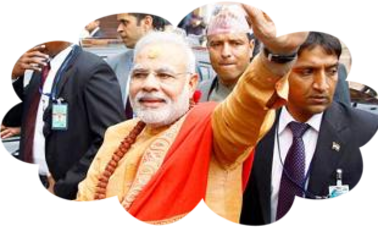 However the most noted entry of Modi in politics took place in 1988 when Modi was elected as organizing secretary of BJP's Gujarat unit. Narendra Modi is noted for his humble background and simplicity of living. Slowly Modi got himself sculptured to an administrator from a Hindu Nationalist politician. Soon the party under the leadership of Modi was recognized and drew a lot of political attention and formed a coalition government in April 1990.
However the most noted entry of Modi in politics took place in 1988 when Modi was elected as organizing secretary of BJP's Gujarat unit. Narendra Modi is noted for his humble background and simplicity of living. Slowly Modi got himself sculptured to an administrator from a Hindu Nationalist politician. Soon the party under the leadership of Modi was recognized and drew a lot of political attention and formed a coalition government in April 1990.In the 1995 state elections BJP won with majority in Gujarat. In November 1995, Modi was elected National Secretary of BJP and was transferred to New Delhi where he was assigned responsibility for the party's activities in Haryana and Himachal Pradesh. On May 1998 Modi was promoted as the general secretary of the Bharatiya Janata Party.
Some of Modi's plan of action helped the BJP to win in the 1998 elections where Modi as a part of the selection committee for the 1998 Assembly elections in Gujarat and he preferred or recommended supporters of Patel over those loyal to Vaghela, in an attempt to put an end to the factional divisions within the party.
When carefully notice it is quite evident of how Modi came upto the national podium would make obvious of how he followed his principles - continuing agitations during the nationwide Emergency, organizing Murli Manohar Joshi's Ekta yatra (journey for unity), and impressing everyone with electoral strategy ahead of the 1995 state elections.
Modi's Achievement as Chief Minister of Gujarat
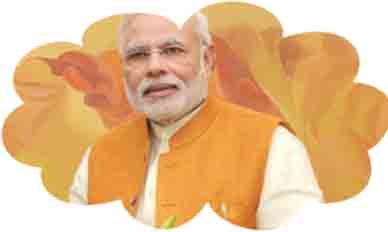 In order to substitute the former BJP veteran Keshubhai Patel, Modi became the Chief Minister of Gujarat on October 7, 2001. Till then Modi has not competed in any election and was less known public figure through he was in important positions like being the national general secretary of the party, besides playing a key role in his mentor L K Advani's Rathyatra from Somnath to Ayodhya in early 1990s.
In order to substitute the former BJP veteran Keshubhai Patel, Modi became the Chief Minister of Gujarat on October 7, 2001. Till then Modi has not competed in any election and was less known public figure through he was in important positions like being the national general secretary of the party, besides playing a key role in his mentor L K Advani's Rathyatra from Somnath to Ayodhya in early 1990s.It is a great achievement for Modi as he takes the credit of being the longest serving chief minister of Gujarat state and also to be the first Chief Minister of India's largest opposition party the Bharatiya Janata Party (BJP) to be nominated as the Prime Minister of India. The achievements of Modi as the Chief Minister of Gujarat is extra ordinary and is very much appreciated not only in India but also across the globe. The state of Gujarat has developed to such an extent that it has become the talking point across the world.
The state of Gujarat was once noted for its drought and natural calamities but after the period Modi had earned such a reputation and popularity. According to an official statement the growth rate of Gujarat is gone up by 13 per cent in industrial and 10.7 per cent in agriculture sectors apart from contributing 22 per cent to India's overall exports.
The industrial growth includes textiles, engineering, chemicals, petrochemicals, drugs and pharmaceuticals, dairy, cement and ceramics, and gems and jewellery, amongst others. Modi was elected as the Chairman of the Central Election Campaign Committee of the BJP in 2013. Because of Modis growing popularity among the people and his innovative way of working made the BJP to decide and select him as the candidate for the Prime Minister post for the 2014 Lok Sabha polls and also there was a landslide victory for Modi. Narendra Modi was sworn in as the Prime Minister of India on 26 May 2014. Some of the successful plans during the period of Modi as Chief Minister of Gujarat,
Panchamrut Yojana - a five-pronged strategy for an integrated development of the state,
Sujalam Sufalam - a scheme to create a grid of water resources in Gujarat in an innovative step towards water conservation and its appropriate utilization.
Krishi Mahotsav -agricultural research labs for the land
Chiranjeevi Yojana - To reduce infant mortality rate
Matru Vandana - Providing preventive and curative services under the Reproductive and Child Health Programme
Beti Bachao - Campaign against female infanticide to improve sex ratio
Jyotigram Yojana - Provide electricity to every village
Karmayogi Abhiyan - To educate and train government employees
Kanya Kelavani Yojana- To encourage female literacy and education
Balbhog Yojana -Midday meal scheme for students to encourage school attendance from poor backgrounds.
But however Modi was highly criticized for the Godhra riots which took place in 2003 just after five months from when he took office as Chief Minister. Modi has always denied the charge that his government was unsuccessful in handling the communal riots.
With his ideas of holistic development and principles of inclusive growth Modi, was trying to make clear to countries like US and UK to stop with their cold shoulder in concern with the riots in Gujarat which killed nearly 1,000 people belonging to the minority government. Finally Modi also succeeded in it were he slowly brought in big-wigs of the industry to invest in the state of Gujarat.
Awards and recognitions
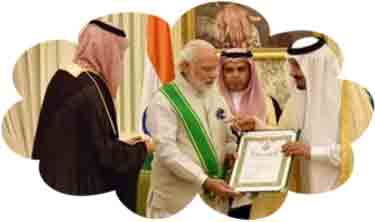 e-Ratna award by the Computer Society of India
e-Ratna award by the Computer Society of IndiaBest Chief Minister of the country - India Today magazine
Asian Winner of the FDi Personality of the Year award for 2009 by FDi magazine.
Modi was featured in Time's 2014 Time 100 list of the most influential people in the world.


